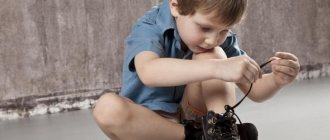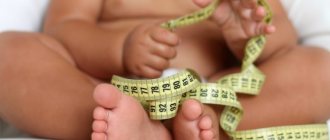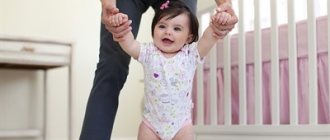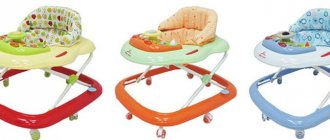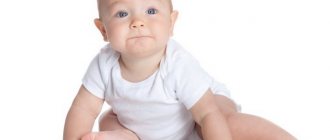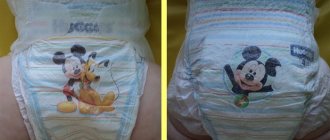The child's leg is growing very quickly. Therefore, children have to buy shoes quite often. It's good if a pair is enough for one or two seasons. Taking into account the fact that high-quality children's shoes are quite expensive, you have to approach their choice especially responsibly. After all, given age, trying on shoes is not always possible or objective. Therefore, so that the selected pair of shoes does not turn out to be small or, on the contrary, too large, it is necessary to know the size of the child’s feet in accordance with the size chart and in centimeters.
How to measure the length of children's feet and how to choose the right shoes is useful for any parent to know.
Principle of determining foot size
The skeleton of the human foot is formed before the age of 20. Until this age, it is at the stage of ossification and is subject to deformation under mechanical influence. In order not to disrupt the anatomical formation of the foot skeleton, parents need to learn how to choose the right shoes for their child.
When taking the first steps, a child needs additional support; shoes that do not constrain or restrict movement are the best helper in this. It is important that it is not too loose, otherwise the baby will quickly get tired and experience pain in the back.
To determine how loose or small a pair is, you should measure your feet regularly, taking into account that one size is 0.5 cm. As you get older, the rate of foot growth decreases. For example, if at 2-3 years the growth rate is 0.5-1.5 cm per year, at 4-5 years this figure drops to 1 cm, and at 6-7 years it is 0.5-1 cm.
Therefore, the older the child becomes, the less often you will exchange the old pair for a new one.
Shoes and stock: how not to make a mistake
It is not so important what model of shoes you choose and for what season.
In any case, new shoes should be with a reserve. And this is not only a reserve “for growth,” as some parents suggest. It is also needed for other purposes. It is necessary to determine the same supply by the insole of the shoes that the child is currently wearing. For comfortable wearing, you will have to add a few more millimeters to its length - you will get a size that is actually suitable for the child.
But the supply of shoes for different seasons should also be different. In summer sandals or sandals, you need to add from 6-8 mm to 1 cm to the actual size. If you choose sports shoes or demi-season shoes, the margin is at least 1 cm, for winter ones - 1-1.5 cm.
And now about why exactly such a (in some cases quite large) reserve is needed. These extra millimeters are necessary for the so-called bend (push). In their absence, the foot begins to deform. It is also important to take into account physiology: when walking, the size of the foot lengthens (almost 7 mm). The extra space in the shoe prevents pressure on the foot, eliminates the possibility of your baby starting to curl his toes, and also allows the foot to grow freely. A larger supply in winter shoes will allow you to wear warm socks, and an additional air cushion will protect your feet from the cold.
And one more note. When buying shoes with a reserve, it is important to pay attention to completeness indicators. Because in some cases, plus 1 cm in length noticeably affects the width of the shoe, which can “dangle” on a thin leg. In this case, there will be no benefit from the stock.
Foot length measurement
To do this we need a sheet of blank paper, a measuring tape and a pencil:
- spread the paper on a flat surface;
- ask the baby to stand on it;
- outline both feet with a pencil, it is important that it is perpendicular
- surfaces;
- Use a ruler or meter to measure the distance from your big toe to the edge of your heels.
As a rule, this parameter is the same for both feet. But sometimes one foot is slightly longer than the other, then when buying shoes you should focus on it.
For a one-year-old baby who has not yet begun to walk, you can determine the shoe size using a rope. Then convert the result into centimeters.
Foot size at different ages. How to measure correctly?
Determining the exact size of a baby's feet is not that difficult. You can easily measure the leg with a string. And then convert to centimeters. If the child does not yet walk, then he is given booties or socks of such a size that they do not squeeze the leg or fall off.
When the baby begins to take his first steps, it is very important to choose high-quality orthopedic shoes that fit him. To do this, you can rely on the table of sizes by age.
However, the data given in the table regarding age and foot length are quite arbitrary and are not always suitable for a particular child.
The length of the foot can depend not only on the age of the baby, but also on his individual characteristics: gender, height, weight, etc. Therefore, it is better to measure the length of your child’s feet yourself and use the table to determine the desired size.
Foot length can be measured in centimeters or inches. In Russia and the CIS countries, measurements are made in centimeters.
To avoid mistakes when measuring your feet, you must:
- It is preferable to take measurements in the evening. By evening, the leg swells a little and becomes larger;
- You need to measure two legs and choose the longest length . Sometimes the length of the right and left feet may be slightly different;
- Put the socks on the child in which he will walk . With a warm sock, the shoes may become tighter;
- Place the child on a thick sheet of paper and trace both feet;
- All measurements must be taken while standing , since under the influence of weight the leg becomes slightly larger than when measured sitting or lying down;
- The measurement is taken from the beginning of the heel to the tip of the big toe (the most protruding point);
- Round the resulting data up to 0.5 or 1;
- When choosing shoes, you can focus on the insole you receive.
The table of children's shoe sizes is especially relevant for those parents who like to shop in online stores. But it is worth considering not only the length of the child’s foot, but also other nuances. For example, size charts differ in different countries, the product does not always correspond to the description, etc.
If a child walks on his toes, parents should be wary. This may be a sign of serious illness.
Useful recommendations from orthopedists
Tip #1
Give preference to shoes with a small margin. This should be done not for the sake of economy, but taking into account the physiological characteristics of the child’s foot. When walking, the load of the whole body falls on the feet, as a result of which they increase in size, swell, and stretch. The fingers move forward a little, taking up free space. Therefore, to prevent the child from experiencing discomfort, it is best to choose shoes that are 1 cm larger than the size of his foot. In addition, the foot will grow over the season and this reserve is quite enough. In the winter season, the free space will serve as a warming “pillow”.
Tip #2
Do not buy a model with a margin of more than 1 cm, since the instep support in it will be displaced. This will negatively affect the process of foot formation and lead to the development of flat feet. Moreover, in shoes that are too large, the child will constantly touch the toe, which will negatively affect his gait.
How fast does the leg grow?
The child's foot does not grow evenly. Sometimes it grows slowly, but there are peculiar leaps when the height, weight and size of the child’s feet increase greatly. In this case, a pair of shoes may not be enough for the season.
Until the age of three, it is advisable to measure the length of the child’s feet every three months.
From three to six you can measure a little less often - once every 4 months.
From 6 to 10 years – once every 5-6 months is enough.
Teenagers often experience a growth spurt. Therefore, it is very important to monitor your child in order to be able to replace his shoes in time.
How to tell if shoes are too small
If you purchased sandals, sneakers or any other shoes that fit, they will have 1 cm of free space and the arch support will be under the arch of the foot. You can determine that a shoe is too small by the following signs:
- in open models, the toes hang over the edge;
- in closed shoes, the child clenches his toes;
- after prolonged wear, redness and calluses appear on the skin of the legs;
- the instep support is located below the arch.
In large models (more than 1 cm of the current size), the instep support is located below or above the arch.
Checking the size in a closed pair
There are no problems with choosing summer shoes, since it will not be difficult to determine whether they are small or large. With winter shoes everything is much more complicated. You can understand that shoes and boots are selected in accordance with the anatomical features of the foot in the following ways:
- Take a clean sheet of cardboard and ask the child to stand on it. Trace the outline with a pencil set perpendicular to the surface. Cut it out and insert it into your shoe. Then you feel with your fingers whether the contour has taken up all the space or whether there is free space left.
- Remove the insole from the shoe and place it on your baby's foot.
- Put your child's shoes on, then press on the edge to determine where the big toe is and if there is room.
Most popular questions
How can you tell if a shoe is too small? Shoes that are too tight are not when a child’s toe touches the toe, but when an adult’s index finger does not fit into the gap between the heel and the heel. What should you pay attention to when choosing? The heel of the shoe should not be too hard, otherwise it will It will be difficult to walk even with the ideal size. In addition, it is worth considering such parameters as the presence of an instep support, the flexibility of the sole, the height of the heel, and the width of the toe.
All of the above recommendations do not apply to shoes with orthopedic insoles, since they are selected individually and are often made to order. This recommendation is explained simply, because corrective shoes must fix the foot in a certain position, so there can be no talk of any sizes for height in this matter.
Errors in selection
When choosing a comfortable model for your child, try to avoid the following mistakes:
- Do not use a measuring tape or ruler for measurements.
- Do not measure the feet of a baby who is sleeping or sitting, as you will get unreliable results. In a standing position, the entire body puts a load on the feet, which is why they increase by almost 6 mm.
- A big mistake would be to stick your finger between the shoe and the heel to determine the space. The child will easily bend his fingers and the measurement will be unreliable.
How to determine the size of children's shoes
So, the measurements have been made, but don’t rush to look at the table. To select the shoe size for children, you need to do a few more calculations.
- Select the number that corresponds to the length of the larger foot in millimeters
- Add 6 mm to the length of the child’s foot - this is the first important value
- Add another 6 mm to the resulting value, then convert both values to cm.
- In the size chart, find size values that correspond to both values. The optimal size for your baby will be the one that is between these values.
If there are two sizes between the readings you calculated, you should focus on the fullness of the baby’s legs - for plump children, choose a larger value, for slender children, a smaller one.
Sizing chart based on foot length
These data will simplify the task of choosing comfortable and correct shoes for your child.
First steps
| Age (months) | Foot length(mm) | UK size | European size |
| 9-12 | 106 | 2 | 18 |
| 12-18 | 115 | 3 | 19 |
| 18-24 | 123 | 4 | 20,5 |
| 24-30 | 130 | 5 | 21 |
| 30-36 | 138 | 6 | 23 |
Children's shoes
| Age (years) | Foot length(mm) | UK size | European size |
| 1 | 123 | 4 | 20,5 |
| 1-1,5 | 130 | 5 | 21 |
| 1,5-2 | 138 | 6 | 23 |
| 2,5-3 | 146 | 7 | 24 |
| 3,5-4 | 153 | 8 | 25,5 |
| 4-4,5 | 161 | 9 | 26,5 |
| 4,5-5 | 169 | 10 | 28 |
| 5,5-6,5 | 176 | 11 | 29 |
| 6,5-7,5 | 184 | 12 | 30,5 |
| 7,5-8 | 192 | 13 | 32 |
| 8-9 | 200 | 1 | 33 |
| 9-10 | 209 | 2 | 34 |
How to choose your first shoes
When choosing shoes for a baby, you need to follow certain rules:
- There should be fastening fasteners. With their help, it will be easier to adjust the width of the boot cavity for the child, depending on the thickness of the sock used.
- Be sure to have a high heel, even if you plan to take summer sandals.
- You should not take shoes larger than the required size. This will only make it more difficult to walk and maintain balance.
- Consider the rise of the child's foot. An infant should not be given very high boots.
- The toe of the boot should be round.
- Pay attention to the season and weather. For example, in the warm season, sneakers are more suitable for a child, but when it gets colder, he will need warm boots.
Advice! Rigid, supportive shoes will be most useful for infants under 3 years of age. If the need for it disappears before this time, there is nothing wrong with that.
Table for one-year-old children
| Centimeters | USA | England | Europe |
| 8,3 | 0,5 | 16 | |
| 8,9 | 1 | 0,5 | 16 |
| 9,2 | 1,5 | 1 | 17 |
| 9,5 | 2 | 1 | 17 |
| 10,2 | 2,5 | 1,5 | 18 |
| 10,5 | 3 | 2 | 18 |
| 10,8 | 3,5 | 2,5 | 19 |
| 11,4 | 4 | 3 | 19 |
| 11,7 | 4,5 | 3,5 | 20 |
| 12,1 | 5 | 4 | 20 |
Definition of completeness
The fullness of the foot is just as important as its length. By measuring this indicator, you can understand how narrow or wide the shoes are. European manufacturers indicate completeness on the label with special letters:
- C – narrow model for a very thin leg;
- D – narrow for thin legs;
- E – for a narrow leg;
- F – for a leg of medium fullness;
- G – for a foot slightly wider than average;
- H – wide model.
Pairs that do not have such markings are designed for average completeness. It is also worth considering the shoe manufacturer. For example, Americans make wider models than Russians, Chinese and Europeans. This is due to the physiological characteristics of the feet of American children.
We calculate the completeness ourselves:
- measure the circumference of the foot (FC) at the widest point;
- We measure the foot length (FL) according to the principle described above.
We make the calculation: (0.25xO) – (0.15xDS) – 16.5. All numbers used in the calculation are constant coefficients.
Fullness of shoes
To determine the fullness, it is necessary to measure the girth of the leg using the heads of the metatarsal bones, i.e. circumference of the widest parts of the foot at the toe. The measurement is performed in the evening, when the load on the child’s feet is maximum. Popular labeling systems in different countries:
| America | AAAA | AAA | A.A. | A | B | C | D | E | E.E. | |
| England | A | B | C | D | E | F | G | H | J | K |
| France | 1 | 2 | 3 | 4 | 5 | 6 | 7 | 8 | 9 | 10 |
In Russia, markings start from 1 to 12, with an interval of 4 mm. Fatness for children is indicated extremely rarely. Manufacturers of children's shoes make them so that it is convenient for parents to determine the appropriate volume, using special Velcro, tightening, and lacing. If the fullness indicator is not indicated, then the product is intended for a standard children's foot. For example, the British manufacturer Clarks produces products for children with the following foot fullness markings:
- E – narrow;
- F – average;
- G – full;
- H – very full.
If the letter A is preceded by numbers from 2 to 6, this means a decrease in girth. When the same numbers appear in front of the letter F - increase. Most manufacturers specialize in producing products only for narrow, normal and wide fullness. In America, labeling is often simplified to three types: N (narrow), M (medium), W (wide). The table shows an example of fullness for size 36:
| F | G | H | J | K | |
| 36 rub. | 21.7 cm | 22.2 cm | 22.7 cm | 23.2 cm | 23.7 cm |
Correct fitting
There are certain rules that must be followed when measuring your feet and further purchasing shoes. The child must put on shoes and walk around in them a little. Ask if he is comfortable in it. Also check to see if he is shuffling his feet, if his gait has changed, and if there is free space between the shoe and the heel.
Considering that up to 5 years of age, children’s feet are covered with a layer of fat, which reduces pain, you should not rely on the child’s simple answer “I’m comfortable!” It’s better to listen to his feelings and follow the tips listed.
Recommendations from pediatric orthopedists:
- It is better to try on and buy shoes in the afternoon, when the blood flow to the legs increases and the foot can become several millimeters longer.
- Take measurements from both feet, as it often happens that one is longer than the other.
- Measure feet only when the child is standing on a flat, hard surface.
If you prefer shoes from foreign manufacturers, be guided by the size chart of the manufacturer's country.
Features of the size chart in different countries
When choosing the right shoe size, you should take into account some differences in sizing charts in different countries.
- The size chart used by Russian manufacturers and in the CIS countries displays the length of the foot in millimeters without allowances.
- The children's net adopted in Europe coincides with the Russian one;
- In the USA and England, foot length is measured in inches, and the measurement method is slightly different.
- In France, the size is indicated by the length of the insole, which is measured in mass units.
In order not to delve into all the intricacies of measurements in different countries, there are tables of correspondence between sizes. Correspondence tables between sizes in different countries, which will allow you to choose the shoe size for children under one year old and from one year to 5 years old, are given below. Materials from the site myadvices.ru were used.
Material of manufacture
The modern market offers a wide range of children's shoes made from a variety of materials. However, which one is best to choose so that the child experiences maximum comfort while walking?
Genuine Leather
This material is considered the best due to its undeniable advantages:
- stretches well, taking the anatomical shape of the foot;
- provides air exchange;
- It allows steam to pass through well, so it eliminates the “greenhouse effect.”
Considering that genuine leather “remembers” the anatomical features of the foot, wearing such shoes that were inherited from older brothers or sisters is not recommended. This will negatively affect your baby's foot development.
Faux leather
A cheaper and alternative option to genuine leather, which has plasticity and elasticity. In the production of leatherette shoes, different materials and technologies are used:
- Due to the breathable membrane, the shoes do not allow moisture to pass through, while ensuring good air circulation;
- contains a layer of genuine leather or wool, therefore it has good thermal insulation properties;
- The absorbent insole removes excess moisture and is subject to repeated washing and spinning.
Textile
Linen, matting, jeans, felt, felt, drape, wool and other textile materials are not inferior to leather in aesthetic and hygienic properties, but have significant disadvantages:
- low moisture resistance;
- frequent pollution;
- difficulty in care.
Another drawback is that when producing shoes with textile uppers, it is difficult to provide high-quality ankle support. In addition, the textile base does not fit well with the hard back. Based on this, we can conclude that it is not recommended for a child to wear such shoes until the age of 7-8, when the foot has not yet formed.
Rubber
Rubber boots are the most suitable footwear for protection from moisture, but they are not breathable. There is one way out - tuck a felt or cloth insole inside. In the winter season, woolen socks will save you.
Design of children's models
A high-quality and comfortable model consists of several parts.
Arch support
This element is an integral part of quality shoes. It provides the necessary support due to which the arch of the foot develops correctly. The arch support also prevents the development of flat feet.
In children's shoes, a weak instep support is used to avoid disruption of natural physiological processes.
Backdrop
A rigid heel is necessary to stabilize the ankle joint. The backdrop is made from a single piece of genuine leather with a slightly rounded top. It does not contain inserts or cutouts. Remember, children under 5 years old are not recommended to wear open-toed shoes. Also, you should not buy models with high tops, which hinder the movement of the ankle and can lead to foot deformation.
Sole
According to the standard, flexible, wear-resistant and grooved soles are used in the manufacture of children's shoes. It should not be too soft, but should bend at the arch and toes. Such a sole will follow the shape of the foot while walking.
The materials used are different: genuine leather (for children under 1 year old), polyurethane, foam rubber, polyvinyl chloride, thermoplastic elastomer.
Additionally, the sole may contain shock-absorbing inserts to reduce stress when walking and jumping on a hard surface.
Heel
Flat-soled shoes distort your gait and ruin your posture. Children's models should have a smooth heel, smoothly transitioning from the toe to the heel. This will prevent the child from falling, slouching and shuffling while walking. The height of the heel, depending on age, varies from 0.5 to 4 cm.
Toe part
Children have a wide toe area and a narrow heel area, so the front of the shoe should be spacious and not restrict the movement of the toes. If the toe part is narrow, blood circulation will be disrupted and the load on the foot will be redistributed.
Fixation mechanisms
Children's shoes can be equipped with laces, Velcro, a zipper or a metal (plastic) fastener. The choice of mechanism depends on the child’s age and abilities. For example, a model with Velcro is better suited for small children, and a model with laces for an older child.
Parents' mistakes
Buying shoes for young children often becomes a real challenge for their parents. A young child cannot yet accurately describe the sensations he experiences when trying on shoes: is it comfortable for him, does it press on his feet or not, and so on. Therefore, parents try different ways to evaluate how suitable a particular pair is for their baby. However, many of them are erroneous and will not provide the necessary information. Here are the most popular methods:
- Insert your index finger behind your baby's heel . If the toe fits, the shoe fits. This is not true. The baby does not understand what they want from him, he can bend his toes, the foot will go further, and at home, in a calm environment, it will turn out that the shoes are too small.
- Place the child's foot on the sole of the boot or boot . Depending on the model, the sole may be much larger than the insole inside. The shoes will be too small.
- Ask the child if he is comfortable . The baby may really like the boots, he will say that they are comfortable, but later it will turn out that they are pressing on him.
- Many parents buy shoes “for growing up”, i.e. obviously take a larger size. This can negatively affect the formation of the child's foot and his gait . Due to the fact that the foot is poorly fixed, its muscles will be in constant tension.
To avoid misunderstandings when choosing shoes for your baby, you need to refer to the size chart and know the length of your child’s feet.
Correlation of fullness with rise
Completeness can only be determined through experiment. There are no problems when choosing sneakers, since they are equipped with various fasteners, with which you can adjust the shoes to your feet. In other cases, you just have to guess and experiment.
Let's consider several cases when it is better to refuse to buy shoes:
- if the child is wearing shoes and there is a void around his shin;
- legs dangle while walking;
- when putting on shoes you need to make extra efforts.
